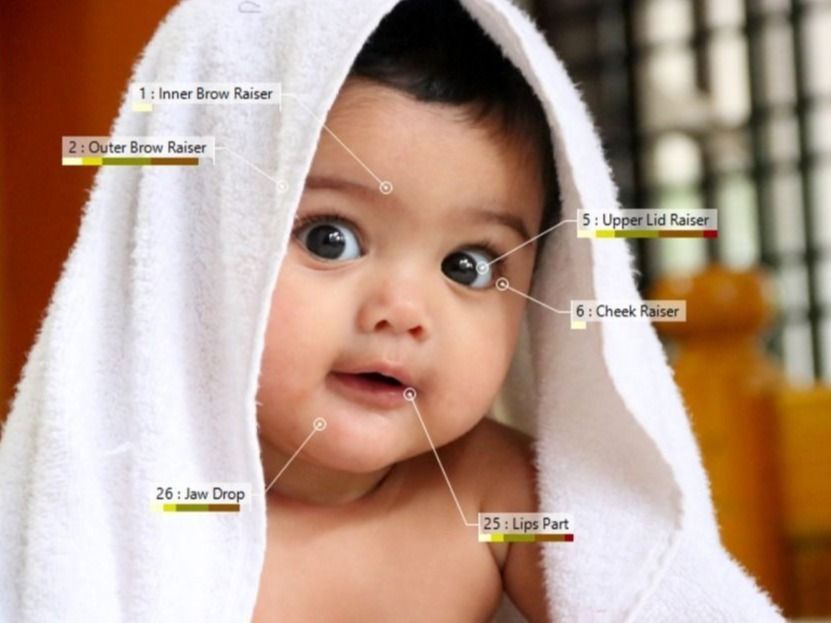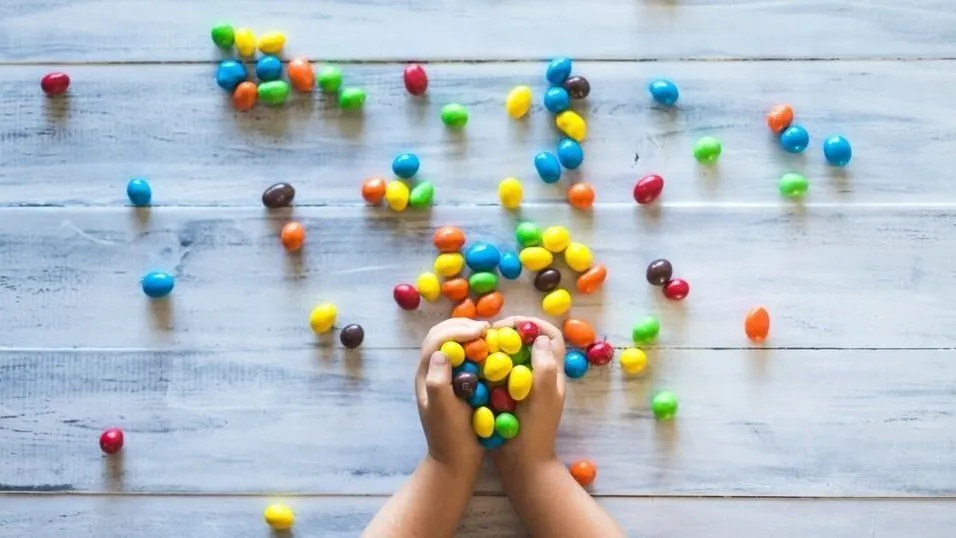5 examples of infant studies
Researchers perform infant studies to properly monitor and understand all kinds of development factors. In this blog post, five examples of infant studies are highlighted.
Posted by
Published on
Wed 23 Oct. 2024
Topics
| Coding Behavior | Developmental Psychology | Emotions | FaceReader | Facial Expression Analysis | Infants | The Observer XT | Child | Child Development |

A lot happens in the development of a child and many factors play an important role in this process. For example, the interaction with parents, siblings, and peers, but also various complex processes in the brain that determine how a child processes information, how well it can concentrate, and how the child behaves towards others. The learning abilities and behaviors are extremely important for the way infants develop.
Throughout development, a child reaches several milestones, recognizable points in the child's development. An important first milestone in social development is the social smile, which is the smile that a baby gives in response to another. It shows that an infant is a social creature right from the beginning of his or her life.
FREE WHITE PAPER: Tools for infant studies
Learn more about the software tools available for infant studies.
- Capture behaviors with video
- Annotate behaviors accurately
- Unobtrusive emotion analysis
Infancy research: 5 examples of infant studies
It is fair to say that collecting data with infants can be difficult. Especially in the early years of their life, when they cannot speak or when they suddenly don’t feel like cooperating during the test. It is hard, or even impossible to explain the importance of cooperation.
Besides all this, there is a risk on low replicability, small sample sizes, limited experimental control, and measurements with limited reliability. Nevertheless, research remains important. In this blog post, five examples of infant studies are highlighted.
Also interesting to read: 'How to study developmental psychology: methods, designs & tools' to discover what you should consider when setting up a study in the field of developmental psychology.
1. Exploring the early development of referential gestural communication
In child development, the pointing gesture is a key milestone that shows the child’s ability to share attention and interests and to communicate specific needs or information. We are talking about referential communication - a triadic type of communication because it involves a triangulation of attention between the child, the interaction partner, and a shared focus of interest (e.g. a toy).
The research team of Salvadori set out to explore whether early socioemotional communication skills can predict how well a child will later develop the ability to point and use gestures. They also investigated whether a child’s natural personality traits play a role in this process. To do this, they used a longitudinal mixed-method approach, combining natural observations, lab-based experimental tasks, and reports from parents.
The interactions were coded for socioemotional communication behaviors, using The Observer XT.
FREE TRIAL: Try The Observer XT yourself!
Request a free trial and see for yourself how easy behavioral research can be!
- Work faster
- Reduce costs
- Get better data
2. Language development and joint engagement in children with Down syndrome
When researchers mention joint engagement, they’re talking about the shared focus between a child and their caregiver on an object or activity. It’s a social skill where both are involved in watching, interacting with, or talking about the same thing. For all children, including those with Down syndrome, joint engagement is an important step toward developing language.
The participants in Mattie's and Fanta's study were 16 young children with Down syndrome. The researchers studied them at two-time intervals. They recorded and analyzed each child's engagement behavior during 15-minute free play sessions between mother and child, using The Observer XT. They focused both on quality and duration of joint engagement behaviors. The research team also measured receptive and expressive language skills at both times.
Discover what the results of the study were in the blog.
3. The role of mimicry in the development of social communication
You smile at your baby and your baby smiles back! Copying facial expressions is one of the great milestones in the social development of a child. The research team of Eliala A. Salvadori, of the University of Amsterdam, conducted a study to investigate the influence of emotional stimuli on mimicry.
The infants (six- and twelve-month-olds) and one of their parents were presented with dynamic videos of unfamiliar adults showing happy, sad, angry, and fearful faces. Using a microanalytic facial coding system, the researchers assessed emotional communication, which included facial expressions and gaze direction.
With this study, the researchers wanted to unravel the mechanisms controlling early development of emotional mimicry.
Baby FaceReader is a state of the art system to automatically detect infant facial expressions in order to help address questions in developmental psychology.
4. Challenging play behavior: does it still exist?
Over recent decades, children are left with fewer opportunities for free play, especially outdoors. Children spend more time indoor in sitting activities, and less time in outdoor play and vigorous physical activity. However, children need feelings of exhilaration now and then.
Research indicates that risky play and risk-taking activities increase children’s physical activity, improve motor/physical competence, increase spatial and perceptual skills, and enhance their ability to assess and manage risk appropriately.
The research team of Ellen B.H. Sandseter addressed the question how risky play is connected to spaces and materials in the physical play environment. The extensive dataset of observations that they gathered, coded, and analyzed using The Observer XT, allowed the researchers to quantify the various behaviors and conclude which risky behaviors occurred, with which toys or tools, in what spaces, and how often.
FREE WHITE PAPER: How to set up a coding scheme
Download here the FREE white paper 'How to set up behavioral coding' and get 7 tips about:
- Defining your behavior group
- Point events
- Coding from a diversity of sources
5. Facial mimicry and social cognition in children with autism spectrum disorder
Research on facial mimicry in individuals with autism spectrum disorder (ASD) has produced mixed findings. While many studies in developmental psychology report deficits in facial mimicry, others suggest that this ability may remain intact in some people with ASD. It’s still unclear whether challenges with facial mimicry are a central feature of ASD or how closely they are tied to broader issues with social cognition.
To shed more light on this subject, Liu's team examined the underlying processes of facial mimicry in this group. They included 21 children with ASD in their study, as well as 22 typically developing children that were matched in age and IQ. To measure facial mimicry, all participants watched images of facial expressions for 6 basic emotions (happiness, sadness, fear, surprise, anger, and disgust). During this task, children’s facial expressions were recorded using FaceReader.

Performing infant studies continues to provide new insights
Infants learn rapidly and they learn from the culture and the people around them. Research helps to understand what infants learn, what they are processing and what factors are influencing the development.
These studies also reveal how early interactions shape cognitive and social skills. By understanding these early stages, we can better support healthy development and identify potential challenges sooner. Additionally, insights from infant research help refine educational practices and parenting strategies to foster optimal growth.
Innovative solutions for psychology research
Free product portfolio
Check out this portfolio of tools and solutions for psychology research, focusing on the observation and analysis of human behavior. These integrated solutions are designed to streamline your research process, from data collection to analysis, ensuring high-quality, reliable results.
References
- Liu, S.; Wang, Y. & Song, Y. (2023). Atypical facial mimicry for basic emotions in children with autism spectrum disorder. Autism Research, 16, 1375–1388. https://doi.org/10.1002/aur.2957
- Mattie, L. & Fanta, D. (2023). Joint engagement and early language abilities in young children with Down syndrome. Frontiers in Psychology, https://doi.org/10.3389/fpsyg.2023.1152559
- Salvadori, E. A., Colonnesi, C., Oort, F. J., & Messinger, D. S. (2024). Predicting Pointing from Early Socioemotional Communication with Mothers, Fathers, and Strangers Through the Lens of Temperamental Reactivity. Developmental Psychology. Advance online publication. https://dx.doi.org/10.1037/dev0001671
- Salvadori, E.A.; Colonnesi, C.; Vonk, H.S.; Oort, F.J. & Aktar, E. (2021). Infant Emotional Mimicry of Strangers: Associations with Parent Emotional Mimicry, Parent-Infant Mutual Attention, and Parent Dispositional Affective Empathy. International Journal of Environmental Research and Public Health, 18, 654. https://doi.org/10.3390/ijerph18020654
- Sandseter, E.B.H.; Sando, O.J.; Kleppe, R. (2021). Associations between Children’s Risky Play and ECEC Outdoor Play Spaces and Materials. International Journal of Environmental Research and Public Health, 18, 3354. https://doi.org/10.3390/ijerph18073354
Related Posts

Eating behaviors in childhood obesity

Learn about people's behavior by observing them
